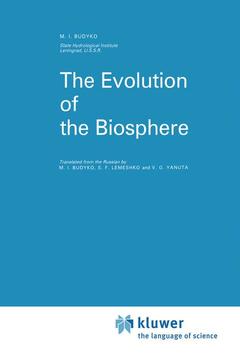The Evolution of the Biosphere, Softcover reprint of the original 1st ed. 1986 Atmospheric and Oceanographic Sciences Library Series, Vol. 9
Langue : Anglais
Auteur : Budyko M.I.

THE STUDY OF THE BIOSPHERE The term 'biosphere' first appeared in the works of the French biologist 1.-B. Lamarck and the Austrian geologist E. Suess in the 19th century. In the 20th century, the study of the biosphere attracted considerable attention, largely due to the research of V. I. Vernadsky (1863- 1945). The results Qf Vernadsky's investigations have appeared in a number of publications, including the monograph The Biosphere published in 1926. This work consists of two parts, The Biosphere in Cosmos' and The Zone of Life', written in a form of speculation and reflection that is rarely used in modern studies. This work concerns the distinguishing properties of the space occupied by organisms and the exceptional importance of the activities of these organisms in the formation of their environment. In this and subsequent studies, Vernadsky has laid the foundations of the science of the biosphere, which today plays an important role in th.c many branches of science concerned with the Earth. Several terms have been suggested for the science of the biosphere, including global ecology (a discipline studying the global ecological system, whose meaning is close to that of the biosphere). One of the most prominent predecessors of Vernadsky was his teacher V.
1 The Structure of the Biosphere.- 1.1. The Boundaries of the Biosphere.- 1.2. The Atmosphere.- 1.3. The Hydrosphere.- 1.4. The Lithosphere.- 1.5. Organisms.- 2 Solar Radiation Andits Transformations.- 2.1. Solar Radiation.- 2.2. The Energy Balance.- 2.3. Distribution of the Energy Balance Components.- 3 Climate And Geographical Zones.- 3.1. Contemporary Climate.- 3.2. Polar Ice.- 3.3. The Theory of Climate.- 3.4. The Hydrological Cycle.- 3.4.1. The Water Balance.- 3.4.2. Relationship between Energy and Water Balances on Land.- 3.4.3. The Water Cycle in the Atmosphere.- 3.5. Geographical Zones.- 3.5.1. Factors of Geographical Zonality.- 3.5.2. A Periodic Law of Geographical Zonality.- 4 Plants.- 4.1. Plants in the Biosphere.- 4.2. The Thermal and Water Regimes of Plants.- 4.3. Photosynthesis.- 4.4. The Productivity of Vegetation Cover.- 5 Animals.- 5.1. Animals in the Biosphere.- 5.2. The Heat Regime of Animals and Man.- 5.3. Ecological Systems.- 5.3.1. The Energy Regime of Animals.- 5.3.2. The Properties of Ecological Systems.- 6 History of the Biosphere.- 6.1. Origin of the Biosphere.- 6.2. Geochronologic Scale and the History of Organisms.- 6.2.1. The Precambrian.- 6.2.2. The Cambrian.- 6.2.3. The Ordovician.- 6.2.4. The Silurian.- 6.2.5. The Devonian.- 6.2.6. The Carboniferous.- 6.2.7. The Permian.- 6.2.8. The Triassic.- 6.2.9. The Jurassic.- 6.2.10. The Cretaceous.- 6.2.11. The Tertiary.- 6.2.12. The Quaternary.- 6.3. Lithosphere and Hydrosphere.- 6.3.1. The Lithosphere.- 6.3.2. The Oceans.- 7 Changes of the Atmosphere.- 7.1. Chemical Composition of the Atmosphere and the Life Activity of Organisms.- 7.2. Chemical Composition of the Atmosphere in Phanerozoic Time.- 7.3. Climates in the Geological Past.- 7.3.1. Methods for Studying Past Climates.- 7.3.2. Precambrian Climates.- 7.3.3. The Climates of the Palaeozoic and the Mesozoic.- 7.3.4. The Tertiary Climates.- 7.3.5. Climate of the Quaternary.- 7.3.6. Climate of the Holocene.- 7.4. Causes of Climatic Change.- 7.4.1. The Studies of the Causes of Climatic Change.- 7.4.2. Effects of Heat Income on the Thermal Regime.- 7.4.3. The Water Cycle Effects of Temperature Variations.- 7.4.4. Climatic Changes in Precambrian Time.- 7.4.5. Climatic Changes in the Phanerozoic.- 7.4.6. Climatic Changes in the Quaternary Period.- 7.4.7. The Climatic Effects of Volcanic Eruptions.- 8 The Evoluton of Organisms.- 8.1. Abiotic Factors of Evolution.- 8.1.1. Studies of the History of Organisms.- 8.1.2. Aromorphosis.- 8.1.3. The Diversity of Successive Faunas.- 8.2. Critical Epochs in Geological History.- 8.2.1. Global Ecological Crises.- 8.2.2. Extinction at the End of the Mesozoic.- 8.2.3. The Thermal Regime of the Dinosaurs.- 8.2.4. The Causes of the Late Mesozoic Extinction.- 8.3. Macroevolution.- 8.3.1. Microevolution and Macroevolution.- 8.3.2. The Size of Organisms.- 8.3.3. General Features of Macroevolution.- 9 Man and Biosphere.- 9.1. Formation of the Noosphere.- 9.1.1. The Noosphere.- 9.1.2. The Brain.- 9.2. The Origin of Man.- 9.2.1. The Difference between Man and Animals.- 9.2.2. The Role of Changes in the Environment.- 9.2.3. The Stages of Anthropogenesis.- 9.3. The Impact of Ancient Man on the Biosphere.- 9.4. Contemporary Man’s Impact on the Biosphere.- 9.4.1. Anthropogenic Ecological Crisis.- 9.4.2. Man’s Influence on the Biosphere.- 9.4.3. Forecasts of a Global Ecological Crisis.- 10 The Future of the Biosphere.- 10.1. Modern Climatic Change.- 10.1.1. The 20th-century Climate.- 10.1.2. Changes in the Chemical Composition of the Atmosphere.- 10.1.3. Anthropogenic Factors in Present Climatic Change.- 10.1.4. Detecting Anthropogenic Climatic Change.- 10.2. Expected Changes of the Biosphere.- 10.2.1. Climatic Conditions of the Near Future.- 10.2.2. The Biosphere’s Effects of Climatic Changes.- 10.2.3. The Distant Future of the Biosphere.- 10.3. Man in the Universe.- 10.3.1. Life in the Universe.- 10.3.2. The Biosphere’s Stability.- 10.3.3. The Uniqueness of the Earth’s Biosphere.- 10.4 Preservation of the Biosphere.- Conclusion.- References.
Date de parution : 02-2012
Ouvrage de 424 p.
15.5x23.5 cm
Disponible chez l'éditeur (délai d'approvisionnement : 15 jours).
Prix indicatif 158,24 €
Ajouter au panierThèmes de The Evolution of the Biosphere :
Mots-clés :
Scale; atmosphere; biosphere; climate; environment; temperature; vegetation; water; hydrogeology
© 2024 LAVOISIER S.A.S.



